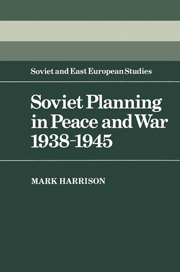Book contents
1 - ECONOMIC PLANNING AND THE SEARCH FOR BALANCE
Published online by Cambridge University Press: 29 October 2009
Summary
For us, for Bolsheviks, a Five Year plan is not something finalised and given once and for all. For us a Five Year Plan, like any plan, is only a plan adopted as a first approximation which we must refine, adapt and perfect in the light of local experience, in the light of experience of plan implementation … Only bureaucrats can suppose that the work of planning finishes with compilation of the plan. Plan compilation is only the beginning of planning. Real leadership in planning is revealed only after compilation of the plan, after checking up on the ground in the course of plan fulfilment, correction and refinement.
(General Secretary I. V. Stalin in a speech in June 1930)INTRODUCTION
To find out how Soviet economic planning was changed by the experience of the Second World War, we must first set out the system of economic planning which had been brought into being before the war broke out. But this is no easy matter. The most important difficulty is that Soviet planning before the war was not a fixed system, with unchanging rules and permanent institutions. Built into the system was the tendency of the system to change.
The prewar planning system did have certain permanent features – a basic structure of hierarchy, information and command – which had been laid down in the formative years of the first Five Years Plan (1928–32). However, this basic structure had not been created all at once according to a ready-made, fully formed model of a functioning socialist economy, although such system-building ideas played an indispensable part in the process.
- Type
- Chapter
- Information
- Soviet Planning in Peace and War, 1938–1945 , pp. 1 - 41Publisher: Cambridge University PressPrint publication year: 1985



